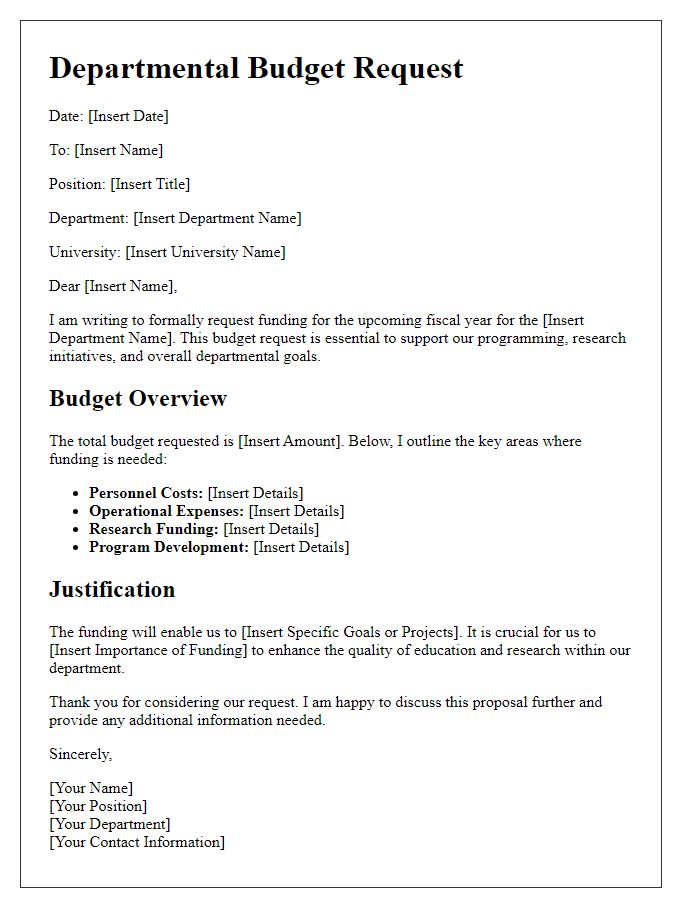Are you ready to take your university departmental budget proposal to the next level? Crafting a convincing letter can make all the difference in securing the funding you need. In this article, we'll walk you through the essential elements of a successful budget proposal letter, ensuring you engage your audience and effectively communicate your department's needs. So, grab a cup of coffee, settle in, and let's dive deeper into the art of proposal writing!

Clearly defined objectives and goals.
The university departmental budget proposal aims to secure funding for various academic initiatives, such as enhancing research capabilities, upgrading technological resources, and expanding student support services. Key objectives include increasing faculty research output by 20% over the next academic year, implementing at least three new workshops to support underrepresented students, and acquiring state-of-the-art laboratory equipment to facilitate advanced experiments. Additionally, goals consist of improving student satisfaction rates as measured by the annual survey by 15% and fostering collaborative projects with local industry partners to provide students with real-world applications of their studies. These targeted objectives and goals are essential for promoting academic excellence and ensuring comprehensive support for all students at the university.
Detailed budget breakdown with justifications.
A university departmental budget proposal requires a comprehensive breakdown of financial allocations that facilitate academic and operational excellence. Essential components include personnel costs, covering salaries and benefits for faculty (such as Ph.D. holders in related disciplines) and administrative support staff. Additionally, equipment expenses (totaling approximately $50,000) involve the acquisition of advanced laboratory instruments for research purposes, ensuring compliance with the latest technological standards. Material costs, projected around $20,000, focus on educational supplies and scholarly resources, including subscriptions to academic journals for curriculum enhancement. Operational expenses such as travel funds (estimated at $15,000), aimed at attending key conferences (for example, the Annual Academic Symposium in San Francisco), contribute to professional development and networking opportunities. Lastly, dedicated reserves (approximately $10,000) allow for unforeseen emergencies, thereby ensuring the department's sustainability and innovation in teaching and research activities.
Alignment with department and university mission.
The departmental budget proposal aims to strategically align financial resources with the mission of the University of California, Berkeley, renowned for its commitment to academic excellence, research innovation, and community engagement. This alignment is critical to support essential programs such as undergraduate and graduate education, interdisciplinary research efforts, and outreach initiatives that foster inclusivity and diversity. Priorities include funding for state-of-the-art laboratory equipment, faculty development workshops, and student support services that collectively enhance the educational experience. The goal is to ensure that department objectives resonate with the university's overarching mission, ultimately contributing to the cultivation of a well-rounded academic environment that prepares students for future challenges while advancing impactful research. Each proposed budgetary line item is designed to reflect the values of integrity, collaboration, and excellence, reinforcing the department's role within the larger academic community.
Anticipated impact and measurable outcomes.
A well-structured departmental budget proposal at a university can significantly impact academic programs and overall student success. By allocating funds for essential resources like educational materials, technology upgrades, and faculty development, departments can enhance teaching quality. For example, investing in updated laboratory equipment in the Chemistry Department may lead to improved student experiment outcomes, increasing pass rates by up to 15% over a semester. Furthermore, providing professional development workshops for faculty can foster innovative teaching methods, which may enhance student engagement and retention rates. Departments can track measurable outcomes through metrics such as graduation rates, course evaluations, and student feedback, ensuring transparency and accountability in budgeting practices. Ultimately, a thoughtfully planned budget can directly contribute to a university's mission of delivering high-quality education and preparing students for future challenges.
Supporting data and precedent documentation.
A university departmental budget proposal requires comprehensive supporting data and precedent documentation to justify funding requests. This includes historical expenditure reports detailing previous budget allocations, such as those from the fiscal years 2021 and 2022, demonstrating trends in departmental spending. Enrollment statistics from the Office of Institutional Research provide insight into student demand for specific programs, influencing resource needs. Additional data may encompass benchmark comparisons with peer institutions--like State University and City College--showcasing average funding levels for similar departments. Faculty workload models indicate potential impacts on teaching and research capabilities when resources are limited, while accreditation requirements necessitate adequate funding to maintain standards, particularly for programs like Nursing and Engineering. Statistical analyses and projections for future enrollment growth can bolster claims for increased budget requests, emphasizing future resource needs.
Letter Template For University Departmental Budget Proposal Samples
Letter template of financial proposal for university department allocation

Letter template of budget justification for university academic department












Comments